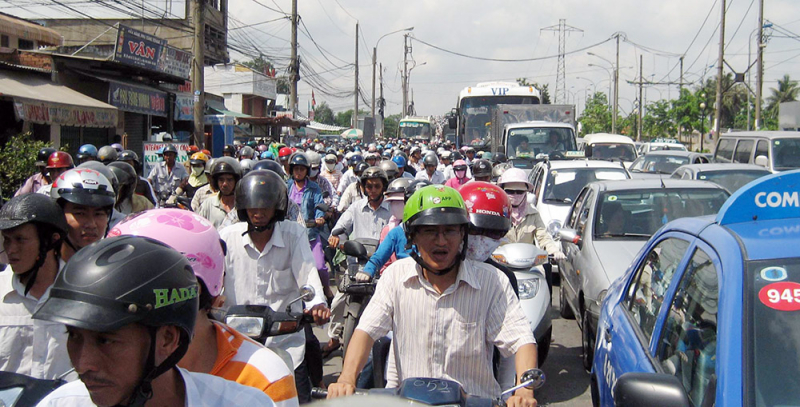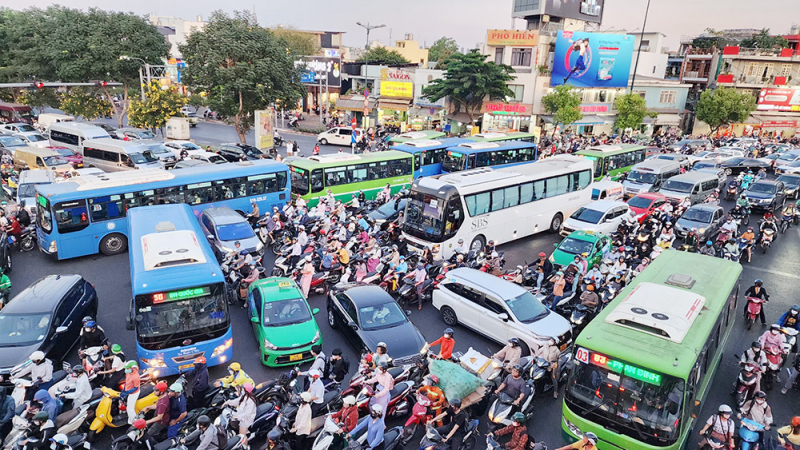Meanwhile, the city has never raised the issue of banning gasoline and diesel vehicles, but only proposed a roadmap to control emissions for cars, motorbikes and old gasoline and diesel vehicles in the face of increasingly serious air pollution caused by vehicles, which is leaving a series of consequences for people's health and lives.
Every week, he has to use a car to travel to the Western region to deal with customers, but since selling his old car for a month, Mr. Chau - a resident in a suburban ward of Ho Chi Minh City is still hesitant and does not dare to buy a gasoline car again.
Explaining this, Mr. Chau worriedly said that he was waiting to see how the government would “ban” gasoline-powered vehicles before buying them. Only when we confirmed that no one was “banning” gasoline and diesel vehicles, but only controlling emissions with old cars and motorbikes, first of all limiting these old vehicles from entering “green traffic zones”, did Mr. Chau run around looking to buy a used, high-end car in recent days.

The project to control vehicle emissions in Ho Chi Minh City, launched by the Public Transport Management Center (GTCC), Department of Construction in mid-August, has outlined a series of realities regarding air pollution and the consequences of emissions from vehicles. From there, it proposes a roadmap to establish beltways and install cameras to monitor cars and motorbikes that do not meet emission standards. At the same time, it proposes a roadmap to replace technology cars and buses with electric vehicles.
According to this unit, after the merger, Ho Chi Minh City has a population of about 14 million people with more than 1 million cars and 10.2 million motorbikes. Road traffic is the main source of emissions, accounting for 88% of NOx, 99% of CO, 79% of SO2 and 88% of dust in total emissions from traffic, causing an estimated economic loss of over 3 trillion VND per year. Measurement results show that the average annual concentration of fine dust in the city is 6 times higher than WHO's recommendation, of which transportation activities account for 40%.
According to the Traffic Management Center, from comparing different data sources, especially the previous research results of the Ministry of Transport , the actual number of motorbikes operating in the city only accounts for about 70% of the total number of registered motorbikes. The number of motorbikes operating regularly is only more than 7 million. In fact, the number of motorbikes operating daily is much higher because people from provinces and cities across the country bring them to the city for use but are not controlled.
Survey results on household travel needs in Ho Chi Minh City in 2024, data from the Department of Registration in 2022 and from the Departments of Construction of Ho Chi Minh City, Binh Duong, Ba Ria - Vung Tau before the merger as well as survey results at transport enterprises show: The number of cars in the city is up to 578,900 vehicles with an average travel distance of 14,320 km/year; there are 18,397 taxis with a travel distance of 1 vehicle of 50,000 km/year; there are 903 small buses, the travel distance of 1 vehicle is up to 69,326 km/year; there are 1,172 large buses, the travel distance of 1 vehicle is 86,228 km/year; there are 660 small passenger cars, the travel distance of 1 vehicle is 28,743 km/year; There are 40,140 large passenger cars, the distance traveled by one car is 16,667km/year; there are 271,700 trucks, the distance traveled by one car is 30,000km/year.
The large number of cars and motorbikes, and the high density of traffic, caused the total amount of CO2 emissions, both indirect and direct, from road traffic in Ho Chi Minh City last year to reach 10.8 million tons. Of which, personal vehicles, including motorbikes and cars, accounted for 49% of the total emissions; freight transport by truck also accounted for 39.9% of the total emissions. The high concentration of traffic in the city center and on main roads has caused serious traffic congestion on many routes during rush hour.
The recent announcement of emission control and the establishment of restricted zones for old gasoline and diesel vehicles has made many city residents worried. But in fact, this is not the first time this policy has been raised. In 2023, the Department of Transport (now the Department of Construction) of Ho Chi Minh City coordinated with the Vietnam Association of Motorcycle Manufacturers and the Institute of Transport Science and Technology to summarize the project "Pilot control of emissions of motorcycles and motorbikes in circulation in the area". At that time, these units determined that with the number of motorbikes registered in the city, if motorbike emissions were controlled, each year, emissions would be reduced by 56,403 tons of CO and 4,800 tons of HC.

Many experts and representatives of these agencies have stated that motorbikes are one of the causes of air pollution in the city. To control emissions from this type of vehicle, the Project has also developed a roadmap for implementation in many phases. In the period from 2023 to 2025, the city will pilot motorbike emission control with a fee of 50,000 VND/vehicle/year for residents in the central area. After 2025, it will be expanded to the inner city area and after 2027, motorbike emissions of residents living in the entire inner city area will be controlled. Emission control for motorbikes will be implemented for vehicles that have been used for more than 5 years.
In the plan to implement solutions to reduce environmental pollution caused by traffic activities in the city in 2020, the Department of Transport also proposed a series of measures to reduce emissions from gasoline and diesel vehicles and control emissions from motorbikes.
Many years ago, the problem of traffic congestion due to the rapid increase in the number of motorbikes and private cars was also raised by delegate Tran Quang Thang, Director of the Institute of Economics and Management, before the City People's Council. Believing that the traffic congestion problem is very serious and contributes to the slow development of the city, Mr. Thang affirmed that the city's roads and infrastructure cannot keep up with the rapid increase in the number of private cars. However, before restricting motorbikes and private cars, the city needs to invest in a public transport system to meet the travel needs of the majority of people.
Motorcycles 5 years or older must have their emissions inspected.
To achieve the goal of reducing net emissions to zero, the Prime Minister issued Decision 876/QD-TTg dated July 22, 2022 approving the action program on green energy conversion and carbon and methane emissions reduction in the transport sector. It sets the goal of gradually limiting and eventually stopping the production, assembly and import of vehicles using fossil fuels by 2040.
For Ho Chi Minh City, the Traffic Management Center proposed to completely ban gasoline motorbikes from participating in technology car services from December 2029. From January 1, 2027, motorbikes circulating in the area will have to meet emission regulations from level 2 or higher. The emission inspection cycle of motorbikes is implemented according to Circular No. 47/2024/TT-BGTVT, in which motorbikes with a production period of up to 5 years have an inspection cycle of 60 months; motorbikes with a production period of over 5 years to 12 years have an inspection cycle of 24 months and motorbikes with a production period of over 12 years have an inspection cycle of 12 months.
Source: https://cand.com.vn/Giao-thong/bai-1-diem-mat-nhung-loai-xe-chay-nhieu-xa-thai-cao-i779010/




![[Photo] National Assembly Chairman Tran Thanh Man welcomes and holds talks with Chairman of the National People's Congress of China Zhao Leji](https://vphoto.vietnam.vn/thumb/1200x675/vietnam/resource/IMAGE/2025/8/31/9fa5b4d3f67d450682c03d35cabba711)
![[Photo] General Secretary To Lam receives Chairman of the National People's Congress of China Zhao Leji](https://vphoto.vietnam.vn/thumb/1200x675/vietnam/resource/IMAGE/2025/8/31/5af9b8d4ba2143348afe1c7ce6b7fa04)
![[Photo] Marching together in the hearts of the people](https://vphoto.vietnam.vn/thumb/1200x675/vietnam/resource/IMAGE/2025/8/31/8b778f9202e54a60919734e6f1d938c3)






















































































Comment (0)